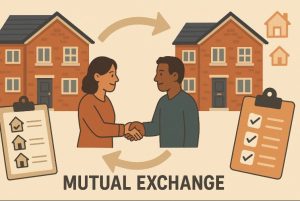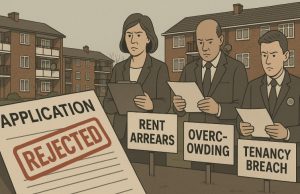Navigating the process of a 2 bedroom council house exchange in the UK requires a clear understanding of the eligibility criteria, rules, and application steps.
Whether you need more space, are downsizing, or relocating, mutual exchange can offer a practical alternative to long housing lists.
This guide outlines the essential information for tenants considering a move through this system, helping them make informed decisions and meet their housing needs more efficiently and effectively.
What Is A 2 Bedroom Council House Exchange And How Does It Work?

A 2 bedroom council house exchange is part of a process known as mutual exchange. This scheme allows council or housing association tenants to swap homes with another tenant who also holds a secure or assured tenancy. The exchange is mutually agreed between tenants but must receive approval from both landlords.
This process offers tenants a practical way to move into a more suitable property without waiting for long periods on a council housing list. People often choose mutual exchange to accommodate a growing family, downsize to a smaller property, relocate for employment, or move closer to support networks.
Unlike tenancy transfers, where you apply to be allocated an empty property, mutual exchange requires direct cooperation with another tenant. The application must be submitted to each landlord involved, and property inspections may be carried out prior to approval.
Who Is Eligible For A Council House Swap In The UK?
Tenants may be eligible to apply for a council house exchange if they have one of the following types of tenancy:
- A secure tenancy with a local council
- A flexible tenancy, which is a type of secure tenancy
- An assured or assured shorthold tenancy with a housing association
Tenants with starter, introductory or demoted tenancies are usually not eligible to exchange. If a tenant has only recently started their tenancy or has been involved in anti-social behaviour, the council may limit their right to move.
The applicant must also not be in breach of their current tenancy agreement. This means that rent should be paid up to date, the property must be well-maintained, and there should be no active legal action by the landlord against the tenant.
What Rules Must Be Followed For A Successful Home Swap?

Successfully completing a mutual exchange depends on meeting your landlord’s legal and administrative requirements. Failing to comply with these rules may result in delays or a rejected application.
Landlord Permissions Are Mandatory
Before making any arrangements to move, both tenants involved in the swap must receive written permission from their respective landlords. The landlords will evaluate the request, carry out inspections, and confirm that the exchange complies with all policies.
Property Suitability Must Be Met
Landlords assess whether the new property is appropriate for the size and composition of your household. For example:
- A single person cannot move into a home intended for a family of five
- Families may be denied a swap if the new home leads to overcrowding
- Under-occupation may be restricted, especially if a tenant wants a property larger than they need
Each council or housing association has guidelines based on bedroom entitlement and household makeup.
Tenancy Conditions Must Be Satisfied
Tenants must not have:
- Any outstanding rent arrears
- A history of anti-social behaviour
- Ongoing legal proceedings relating to the tenancy
- A property that has been neglected or damaged
Failure to meet these conditions is a common reason for swap applications being declined.
Tenancy Types Must Be Eligible
Only tenants with secure, flexible, or assured tenancies are generally permitted to swap. Those with introductory, starter, or demoted tenancies are usually ineligible, unless their tenancy status changes before the swap is completed.
Legal Compliance Is Required
Landlords must also ensure the proposed swap meets all regulatory requirements, including those related to:
- Gas and electrical safety checks
- Fire safety standards
- Local planning or housing allocation policies
Tenants must co-operate with any inspections or administrative steps required to meet these standards.
How Do You Apply For A Mutual Exchange Of A Council House?
Applying for a mutual exchange involves several steps that need to be carefully followed. The process includes:
- Informing your current landlord of your intention to exchange
- Registering with an approved mutual exchange platform such as HomeSwapper or House Exchange
- Searching and selecting suitable properties listed by other tenants
- Viewing the property to ensure it suits your needs
- Submitting a formal exchange application to both landlords
After applications are received, landlords may conduct home inspections, verify tenancy status, and assess the suitability of the swap. If everything is in order, a date will be agreed upon, and both tenants will sign new tenancy agreements.
Some councils provide free access to online exchange platforms, while others may require a small fee. It is worth checking with your landlord before registering.
Can You Swap A Housing Association Property With A Council Property?

A housing association tenant can exchange homes with a council tenant, provided both landlords give approval. This is a common arrangement, especially in areas where mixed tenure properties are common. The process is similar to a regular mutual exchange and involves the same eligibility checks and inspections.
The exchange must not violate the rules of either landlord, and the new home must meet the housing needs of both tenants involved. Some housing associations may impose additional criteria, such as age restrictions, household income limits, or specific property types not being eligible for exchange.
Here is a comparison table showing key differences tenants may encounter during an exchange between a housing association and council property:
| Criteria | Council Tenant | Housing Association Tenant |
| Tenancy Type | Secure or Flexible | Assured or Assured Shorthold |
| Exchange Approval Required | Yes | Yes |
| Additional Rules | Local authority allocation policies | May include specific eligibility rules |
| Common Exchange Limitations | Overcrowding or under-occupation | Restrictions on certain properties |
What Should Tenants Check Before Agreeing To A House Exchange?
Agreeing to a home swap is a significant decision. Tenants must carry out their own checks to ensure the property and tenancy arrangement suit their needs and expectations.
Assess The Property’s Physical Condition
It’s essential to thoroughly inspect the property before agreeing to a swap. Look for:
- Signs of damp, leaks or poor insulation
- Damage to fixtures and fittings
- Issues with heating, plumbing or electrics
Remember, once you move in, you may become responsible for any maintenance not covered by your new landlord.
Understand The Financial Commitments
Tenants must evaluate the affordability of the new home, including:
- Monthly rent payments
- Service charges (common in flats or housing association properties)
- Council Tax band
Ask for recent statements or speak with the current tenant to get a clear idea of expected costs.
Review Local Amenities And Services
Location is critical. Consider whether the property is near:
- Schools and nurseries
- Public transport routes
- Healthcare facilities
- Employment opportunities
If you rely on certain services or need access to specific areas, ensure the new location aligns with your lifestyle.
Confirm Suitability For Health And Mobility Needs
If anyone in your household has a disability or mobility issue, assess whether the property offers:
- Step-free access or lifts
- Wide doorways or accessible bathrooms
- Proximity to medical facilities or support networks
The property must support your physical needs just as well—or better—than your current home.
Check The Type Of Tenancy Being Offered
The new tenancy agreement may differ from your current one. Moving from a secure to an assured tenancy, for instance, can affect your rights. Check:
- Your right to buy (may not transfer)
- Succession rights (inheritance of tenancy)
- Tenancy duration and renewal policies
It’s important to read the new agreement carefully and seek advice if you’re unsure.
Clarify Responsibilities For Repairs And Modifications
Make sure to understand what repairs, redecoration, or improvements you are responsible for once you move in. You may be expected to:
- Fix minor cosmetic issues
- Replace worn-out furnishings or fittings
- Complete necessary redecorating
Clarifying these responsibilities in advance can help avoid disputes later.
What Are The Common Reasons A Council May Refuse An Exchange?

Although many applications are approved, there are several valid reasons a landlord might refuse a mutual exchange:
- Either party has significant rent arrears
- One of the properties is subject to legal action, such as a possession order
- One of the homes is deemed unsuitable for the incoming tenant in terms of size
- The applicant is in breach of tenancy, such as property damage or anti-social behaviour
- The tenant holds a non-qualifying tenancy type (e.g. introductory or demoted)
In these cases, the council or housing association must give a written explanation. If a tenant disagrees with the decision, they may be able to request a review. Councils typically allow 21 days for this appeal to be submitted.
What Happens After Your Mutual Exchange Is Approved?
Once the exchange has been approved by both landlords, the next stage involves formal arrangements to carry out the move. Each tenant will need to:
- Sign a new tenancy agreement specific to the new property
- Confirm their intention to move on an agreed date
- Inform utility providers, local authorities, and other relevant services
- Ensure both properties are left clean and in good condition for the incoming tenant
It is important to note that tenancy rights may change depending on the new landlord. For instance, a secure tenant may become an assured tenant after the move, and this could affect certain rights such as the right to buy.
How Can Downsizing Or Upsizing Affect Your Exchange Application?

The number of bedrooms in a property must be suitable for the size of the household. Councils apply bedroom entitlement rules to ensure homes are not under-used or overcrowded. Downsizing can sometimes give a tenant priority in the exchange process, particularly where they are moving from a larger property to one that more accurately reflects their needs.
Conversely, upsizing requires justification. A growing family or a medical need requiring separate bedrooms could qualify. However, if a tenant is applying for a home larger than they are entitled to, the application is likely to be refused.
Here is a table outlining typical bedroom entitlement guidelines in England:
| Household Composition | Bedroom Allocation |
| Single adult or couple | 1 bedroom |
| Two children under 10 (regardless of gender) | 1 bedroom |
| Two children over 10 (same gender) | 1 bedroom |
| Two children over 10 (different gender) | 2 bedrooms |
| Adult requiring overnight carer | Additional bedroom |
Tenants should check with their local council for any additional local policies that may apply.
Where Can Tenants Find 2 Bedroom Council House Exchange Opportunities?
Finding suitable exchange opportunities is easier today thanks to several dedicated platforms and resources. These platforms allow tenants to list their current property and search for matches based on size, location, and other preferences.
Key resources include:
- HomeSwapper.co.uk – the largest mutual exchange service in the UK
- HouseExchange.org.uk – supported by housing associations and local authorities
- Local council websites and housing registers
- Community centres and housing advice charities
- Social media groups focused on local housing and swaps
Once a suitable match is found, tenants must contact their respective landlords to begin the formal application process. Registration on these platforms often includes uploading property photos, writing a short description, and specifying preferred swap locations.
Conclusion
A 2 bedroom council house exchange provides a valuable solution for tenants whose current homes no longer meet their needs. By understanding the requirements, following the correct procedures, and preparing thoroughly, tenants can increase their chances of a successful move.
From checking eligibility to securing landlord approval, every step matters. This approach not only helps tenants improve their living conditions but also contributes to better use of social housing across the UK, ensuring homes go to those who need them most.
FAQs
What’s the difference between a tenancy transfer and a mutual exchange?
A tenancy transfer is when you apply to move into an empty council property, while a mutual exchange involves swapping homes with another tenant.
Can you do a council house swap if you have rent arrears?
Generally, no. Rent arrears must usually be cleared before an exchange can be approved.
Do you need to pay to use mutual exchange websites?
Some platforms require a fee unless your landlord has a partnership that grants you free access.
How long does a mutual exchange take to be approved?
It varies by landlord, but typically between 6 to 8 weeks, depending on inspections and paperwork.
Is it possible to exchange homes between different cities or regions?
Yes, mutual exchanges can take place across different councils or regions if both landlords approve.
Can a council refuse a swap for overcrowding reasons?
Yes, if the new home would be too small or not meet space standards for your household, the application can be denied.
Do you keep the same tenancy terms after a swap?
Not always. Tenants may move from a secure tenancy to an assured one depending on the new landlord’s policies.






